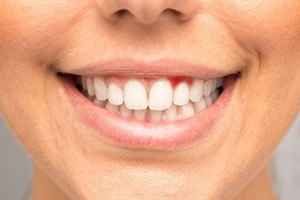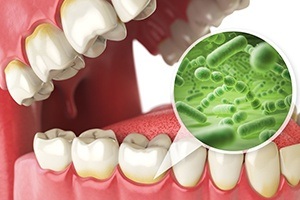Periodontal Therapy – Bloomfield, CT
Healthier Gums for
a Healthier You

Many people greatly underestimate the importance of their gum health. In fact, the state of your gums can have an influence on your teeth, your smile’s aesthetics, and even your overall health. Here at Family Dental Practice of Bloomfield, we take the well-being of your gums seriously. If you develop periodontal (gum) disease, we have treatment options available to help you manage and perhaps even reverse the problem with advanced periodontal therapy in Bloomfield, CT.
Why Choose Family Dental Practice of Bloomfield for Periodontal Therapy?
- On-Staff Periodontist
- Conservative, Comfortable Treatment
- Thorough and Personalized Care
What Is Gum Disease?

Simply put, gum disease is inflammation of the gum tissue. It occurs when bacteria invade the gums and spark an immune response. The mildest form of gum disease is known as gingivitis, and it is characterized by symptoms like red, swollen gums and gums that bleed easily when you brush. Advanced gum disease is called periodontitis, and it is often accompanied by gum recession, lose of bone around the teeth, loose teeth, and other serious symptoms.
Gum disease (also called periodontal disease) is an infection of the tissues that support your teeth. It is a major cause of tooth loss in adults. Because gum disease is usually painless, you may not know you have it. At your regular checkup, the hygienist will measure the depth of the shallow v-shaped crevice (called a sulcus) between your tooth and gums to identify whether you have gum disease.
Gum disease is caused by plaque, a sticky film of bacteria that constantly forms on the teeth. These bacteria create toxins that can damage the gums.
Periodontal diseases attack just below the gum line in the sulcus, where they cause the attachment of the tooth and supporting tissues to break down. As the tissues are damaged, the sulcus develops into a pocket; generally, the more severe the disease, the greater the depth of the pocket.
Periodontal diseases are classified according to the severity of the disease. The two major stages are gingivitis and periodontitis.
Gingivitis

In the early stage of gum disease, called gingivitis, the gums become red and swollen and bleed easily. At this stage, the disease is still reversible and can usually be eliminated by daily brushing and flossing.
Periodontitis

In the more advanced stages of gum disease, called periodontitis, the gums and bone that support the teeth become seriously damaged. Whereas healthy gums and bone anchor teeth firmly in place, infected gums can cause teeth to become loose, fall out, or need to be removed by a dentist.
Some factors increase the risk of developing periodontal disease:
- Tobacco smoking or chewing
- System-wide diseases such as diabetes
- Some types of medication such as steroids, some types of anti-epilepsy drugs, cancer therapy drugs, some calcium channel blockers, and oral contraceptives
- Bridges that no longer fit properly
- Crooked teeth
- Fillings that have become defective
- Pregnancy
If you notice any of the following signs of gum disease, see the doctor immediately:
- Gums that bleed easily
- Red, swollen, tender gums
- Gums that have pulled away from the teeth
- Persistent bad breath or bad taste
- Pus between your teeth and gums
- Permanent teeth that are loose or separating
- Any change in the way your teeth fit together when you bite
- Any change in the fit of partial dentures
It is possible to have periodontal disease and have no warning signs.
That is one reason regular dental checkups and periodontal examinations are very important. Treatment methods depend on the type of disease and how far the condition has progressed.
Good oral hygiene at home is essential to keep periodontal disease from becoming more serious or recurring. You don't have to lose teeth to periodontal disease. Brush regularly, clean between your teeth, eat a balanced diet, and schedule regular dental visits for a lifetime of healthy smiles.
Scaling & Root Planing

Scaling and root planing is one of the most common treatments for gum disease. Essentially, it is a deep cleaning of the mouth. We remove plaque and tartar from both above and below the gumline. We also smooth out the roots of teeth in order to make it more difficult for bacteria to cling to them. Following scaling and root planing, regular checkups are necessary so we can continue to keep a close eye on your gum health.
